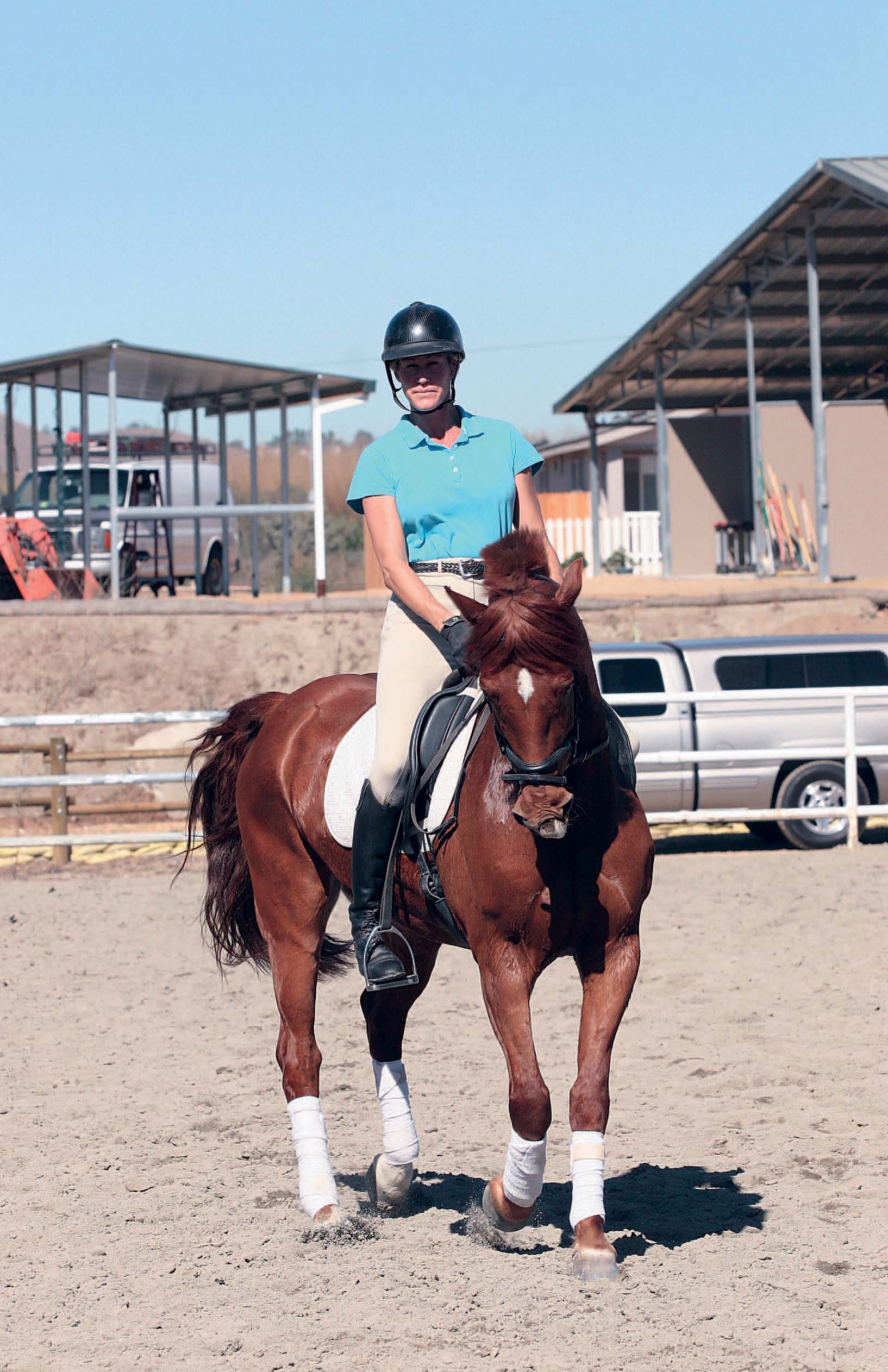


Lateral Work
Many riders, in particular dressage riders, strive to master lateral work. Not only does lateral work make a pretty picture, but correctly done, it also demonstrates that the basic training of the horse has been achieved and that the work is moving in the right direction. But lateral work is more than this. It teaches the rider how to keep the horse straight and how to use the diagonal aids correctly. Lateral work increases the horse’s engagement (shoulder-in, haunches-in, and half pass) and loosens the shoulders (shoulder-in and half pass), and leg yielding loosens the horse’s back.
Suppling Exercises
Suppling a horse is an important concept at all levels of English riding. For a horse to remain sound throughout his life, he must remain flexible.
Leg Yielding
Leg yielding is one exercise that will help achieve suppleness. In the test, it also shows obedience and correctness of the horse’s response to the rider’s influences. It is not only an exercise in and of itself but also a tool for circles, corners, and turn-on-the-forehand, and it narrows the horse’s base of support for better balance. In the leg yield, the horse moves in a forward, sideways movement, slightly bent away from the direction of travel.
The most common problem in leg yielding is lack of alignment; usually the horse’s neck is twisted at the withers. The horse’s body parts—neck and main body—should all be aligned. To avoid alignment problems, wait until you’ve straightened out of your turn before you begin to leg yield. Then ask your horse for a slight flexion in the opposite direction of travel by squeezing the rein (for instance, the right rein if you’re moving toward the left) until you see a little bit of your horse’s eye. Use your diagonal aids as you ask for the leg yield, but make sure to half halt adequately on the outside rein (if you’re moving in that direction) as you ask for the leg yield; otherwise, your horse will keep moving forward and not sideways. The key here is to displace the horse’s energy sideways. Look up, find a spot on the wall to ride to, and think “a step forward, a step sideways” as you ride the leg yield. To the spectator, your horse should appear to be straight and moving sideways energetically, with his legs crossing and uncrossing.
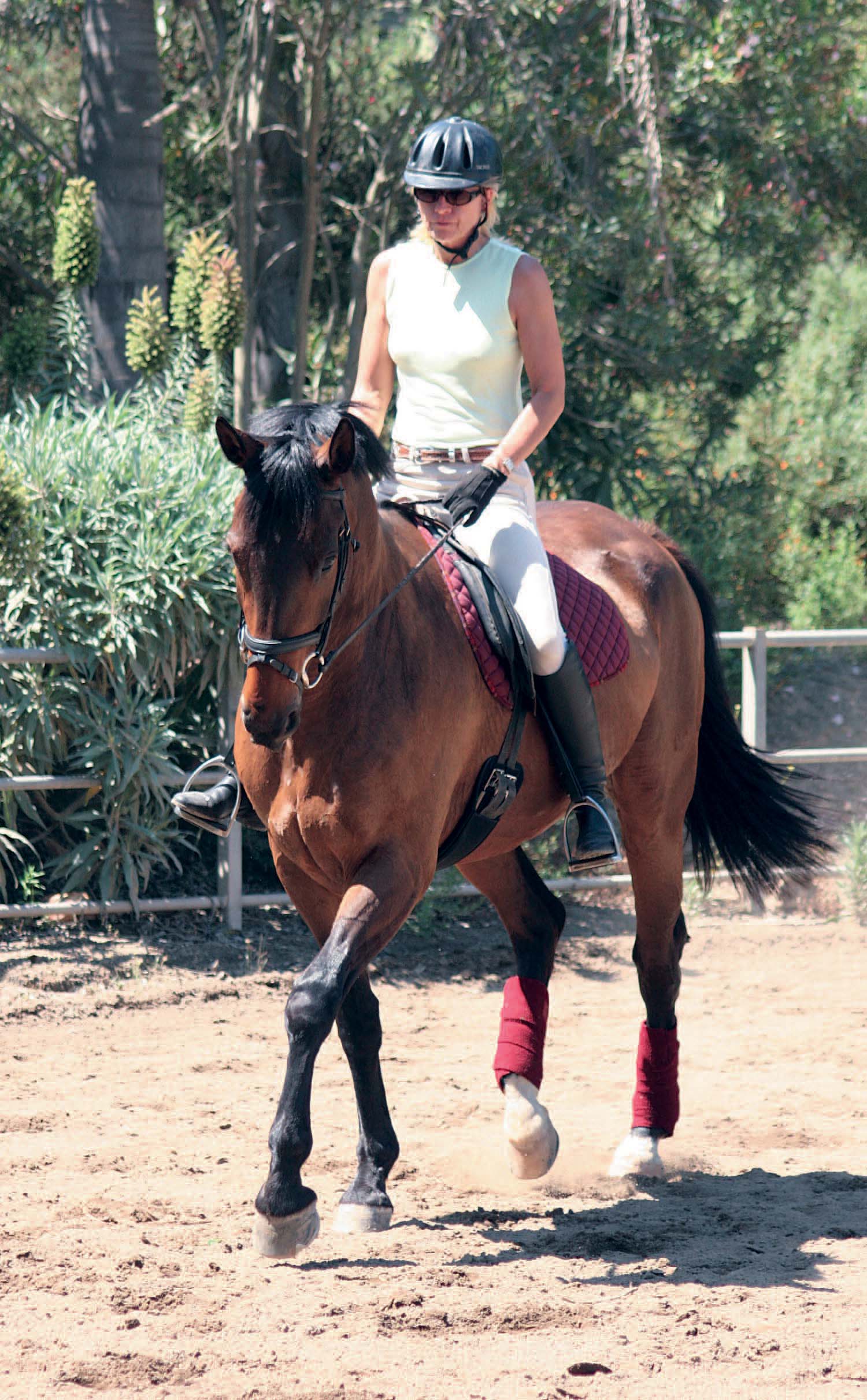
For a correct leg yield, the horse must be bent slightly away from the direction of travel, as shown.
Turn-on-the-Forehand
Although turn-on-the-forehand has no gymnastic value, the turn-on-the-forehand can teach both horse and rider how to use and respond to the very important basics of inside leg to outside rein. It can also help a horse understand how you’d like him to use his haunches. It is useful when you want a horse to move sideways—away from another horse or into a fence you’d like to open while mounted. Your horse should move away from your inside leg aid and into the outside rein, neatly crossing his inside leg over his outside leg, all the while keeping the same tempo as he makes the turn. Even though you’ll remain in one spot, your horse should keep his energy up while making the turn. He should step around his front legs, which will continue to stay in motion, stepping a little bit forward while turning about.
This exercise is often mistakenly started from a halt, which causes problems. If you’re rooted to the spot, your horse’s haunches will stop stepping underneath, and the result will be the circus pony pivot. Therefore, approach it from the walk. Walk down the long side of your school. Apply a half halt, and slow your horse’s walk momentarily. As you feel him shorten his stride, flex his head slightly toward the wall, bending him a little to the outside. Bring your inside leg behind the girth, and apply your outside leg at the girth. Now half halt the inside rein again, then use your outside leg to ask your horse to cross his outside hind leg over to create the turn-on-the-forehand. Each time you apply your outside leg, immediately half halt with your inside rein. (A brief note: This is that all-important basic aid of inside leg to outside rein. We’ve reversed it here to outside leg to inside rein because we want to use the wall of the school to prevent the horse from barging through your half halt.) When you finish the exercise, move off in the new direction and repeat from the new rein on the other long side.
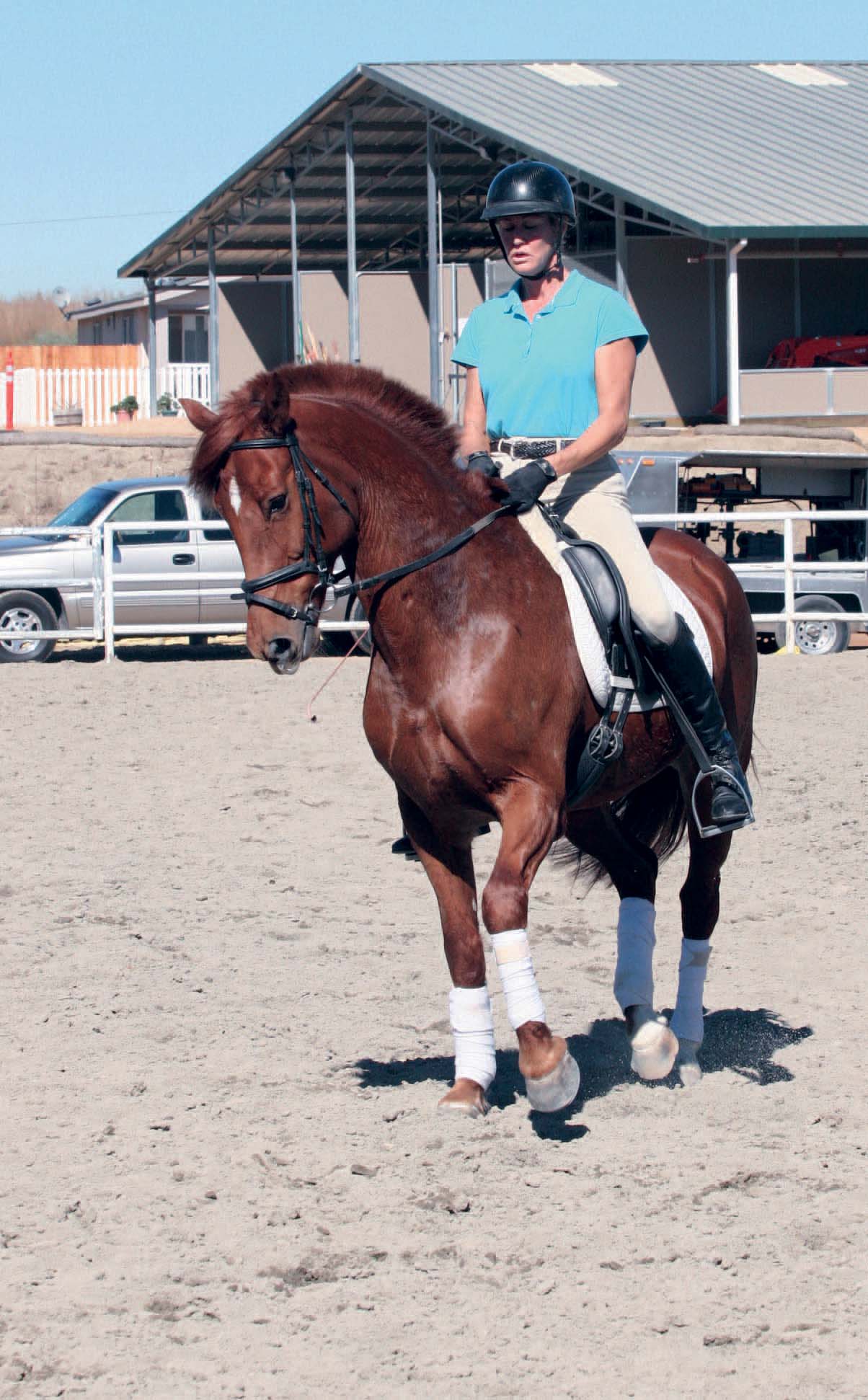
A horse and rider begin a turn-on-the-forehand.
Two-Track Movements
Two-track movements are so called because they require the horse’s body to travel on two different paths. The shoulder-in asks the horse to bend toward one side yet continue moving in another. The haunches-in and out (travers and renvers), half pass, and turn-on-the-haunches ask the horse to move in the direction of his bend. The aids are all the same for this second group of movements; only the intensity of the aid varies.
The Shoulder-Fore and the Shoulder-In
The shoulder-in is one of the most challenging of the lateral movements. It is the first time the horse is asked to bring his hips closer together, flex his hocks, and swing his shoulders to one side. In dressage, it is the preparation for all other lateral exercises. It is beneficial in other disciplines because it teaches a horse straightness, which helps create balance, and it supples his body, which makes carrying a rider easier.
Shoulder-fore is the precursor to the shoulder-in. Shoulder-fore has a lesser degree of angle and bend. The aids are the same but are used with less intensity. It’s best to teach the horse this movement first; once the horse understands how to flex his hocks, the angle can be increased. When you teach a horse shoulder-in, he often doesn’t understand and will give a steep angle, similar to a leg yield. It’s easy for him to swing his shoulders but harder for him to carry his weight in his hocks. So angle isn’t better when approaching a shoulder-in.
For both the shoulder-in and shoulder-fore, your inside leg should be at the girth to maintain lateral bend. Your outside leg is behind the girth to stop the haunches from falling out. Flex your horse to the inside, and make your outside rein more solid to support the bend and help your horse stay on the track. Sit slightly to the inside with more weight on the inside seat bone; you achieve angle in this movement by turning your upper body. Your horse will learn this means to bring his forehand in. Increase the turning of your body, and the horse will increase the angle to create the shoulder-in. Most people can’t feel the shoulder-fore, so it is helpful to ask someone on the ground to point out how far you are leaving the track.
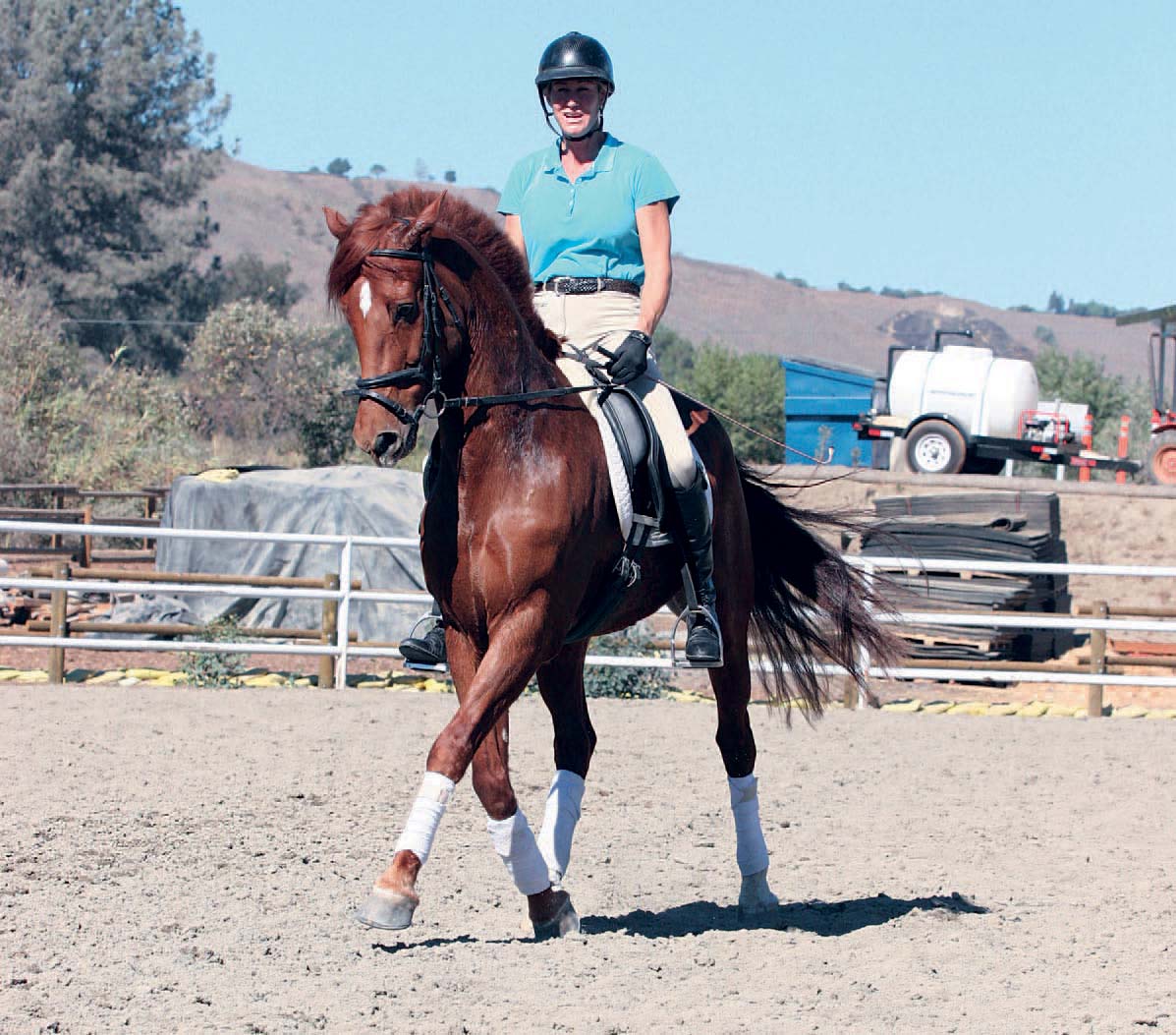
A horse and rider school the shoulder-in.
Use your corner to establish a bend before you begin. Then send your horse down the long side in a shoulder-in or a shoulder-fore. You can also ride a small circle to establish the bend, then ride the movement out of it. Try the smaller angle for a few strides, bring your horse back to the track, brighten the gait, and increase the angle to shoulder-in. Finish the movement by straightening the shoulders with your outside rein, pushing your inside leg against the horse’s side, turning your body forward, and riding straight ahead.
Haunches-In
Haunches-in (also called travers) is the most advanced way to teach your horse inside bend. For a correct haunches-in, your horse must move with his front legs and shoulders on the track and his haunches off the track (haunches-out, also called renvers, requires a horse to move with his shoulders off the track and his haunches on the track). Sit facing straight ahead with your shoulders aligned with your horse’s shoulders. Keep your inside leg at the girth (calf supports the bend and keeps the horse at the track) and your outside leg behind the girth (pressure from your calf asks the haunches to swing in). The outside rein helps keep the horse’s neck straight, and the inside rein asks for a slight flexion to the inside. Keep more weight on the inside sitting bone. Your horse’s neck and shoulders should be parallel to the long side, and the rest of his body should be bent to the inside.
Horses often lean to the wall, so ask for the haunches-in on the centerline or quarterline instead. If you’re getting a lot of neck bend, you’re probably using your reins in place of proper leg aids. Check your aids and try again. Remember to keep the neck and shoulders straight. If you have trouble maintaining the bend, start the haunches-in from a circle to create the bend, then ride straight ahead in haunches-in. Return to the circle if you lose your bend.
The Half Pass
The half pass is a collected movement that demonstrates the horse is supple enough to move forward while bent in the direction of travel, with good balance and at the correct tempo. As a horse moves through the levels, the bend becomes steeper, and the movement travels a greater distance. The half pass develops out of the leg yield and the shoulder-in. The aid for the half pass is to begin in shoulder-fore, then half halt the outside rein to bring the horse over in a half pass. You should sit a little bit more toward the bend.
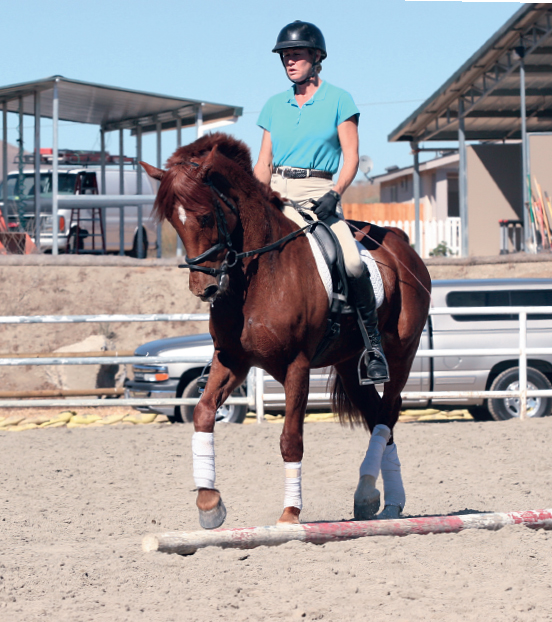
A horse and rider school the half pass with the help of a ground pole.
Riders often get caught up in producing an angle and end up getting the wrong response. Imagine riding haunches-in on the diagonal instead. Line up four poles in a row on the long diagonal from F. Ride a straight line from F to the first pole, then ride a slight angle (from haunches-in) on the first pole, and finally ride an increased angle on the last three poles. Don’t just take any old angle. Be aware of what your horse is giving you. To ride the half pass from start to finish, turn down the centerline at A on the left rein. Remain straight until you reach D, where you will ride your shoulder-fore in preparation. Next, pretend the poles are set from D to E, and ride haunches-in along those imaginary poles. Start with a gradual angle, and once you feel the horse is forward and the bend is good, increase the angle. At the end, if your horse starts to weaken, increase the forward and decrease the angle. It’s the same philosophy as in the shoulder-in.
The Turn-on-the-Haunches
The turn-on-the-haunches is a gymnastic exercise, meaning it develops the horse’s body. The exercise engages the horse’s hindquarters by teaching him how to shorten his body and bring the haunches closer to the front end. It’s difficult to feel what’s going on with the haunches at the walk, and because of the slower pace, horses can be very evasive. Therefore, ask a friend on the ground to watch you until you get the hang of it.
The essence of turn-on-the-haunches is that the horse marches around his inside hind hoof. His inside hind hoof should step in place while the outside hoof and front hooves move around it. The horse’s hind hooves should stay in the center of the circle, and his body should move around the periphery. Your horse should move in a pure walk with a good four-beat rhythm and a steady tempo. He should remain balanced and on the bit, looking and bending in the direction of travel. The exercise should begin and end in the same spot.
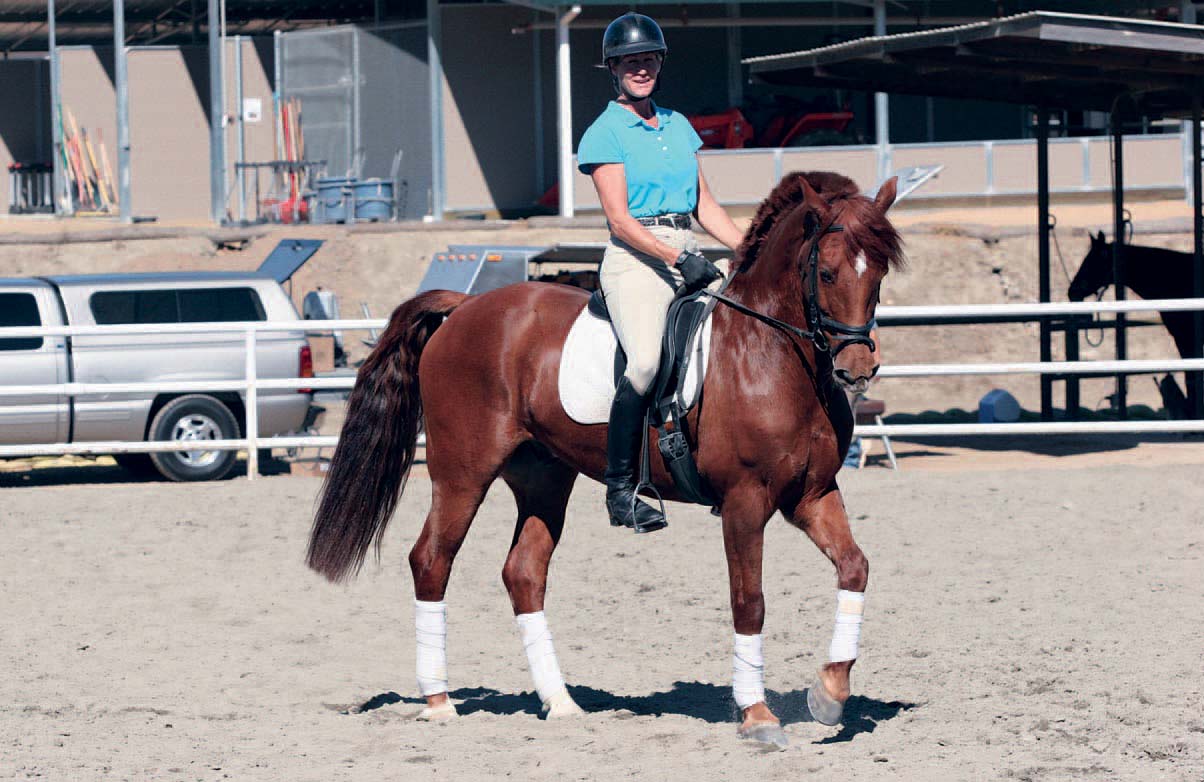
This is the first step in a turn-on-the-haunches: the rider asks for a slight half pass.
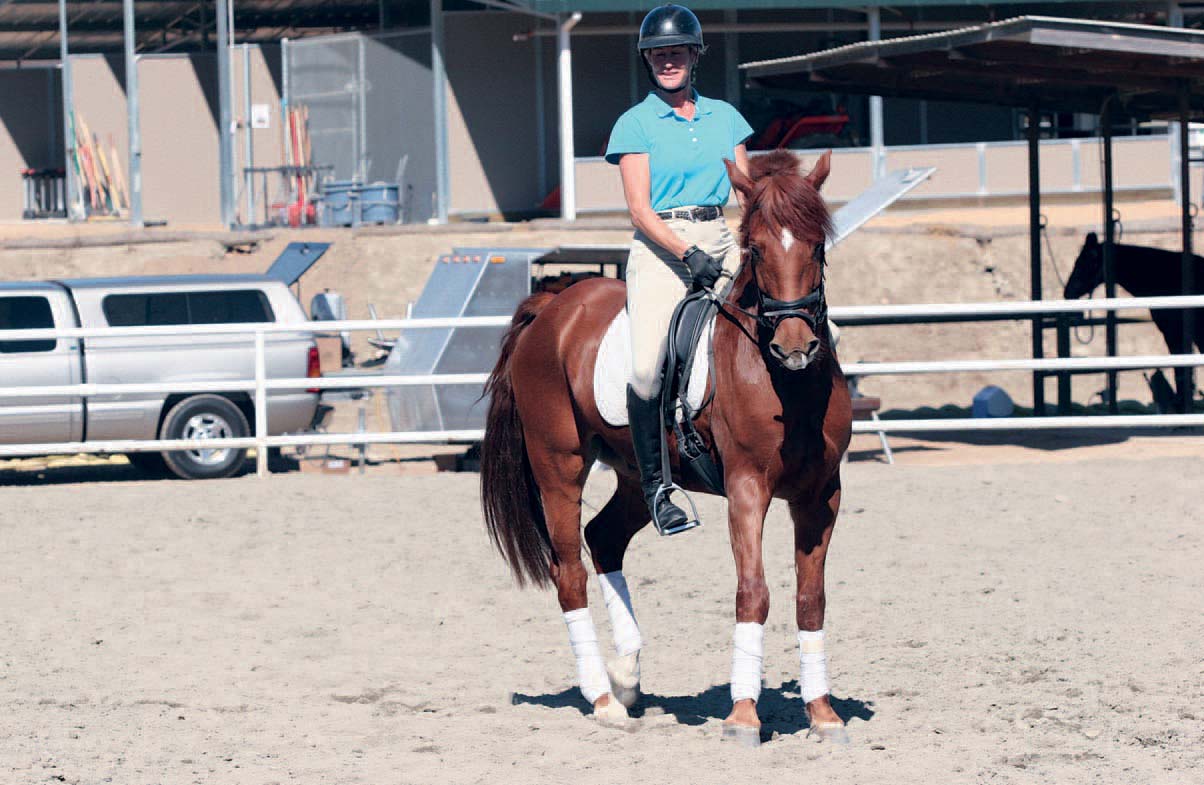
Step 2 in the turn-on-the-haunches: the rider uses her outside rein and leg to prepare the horse to turn his forehand around the haunches.
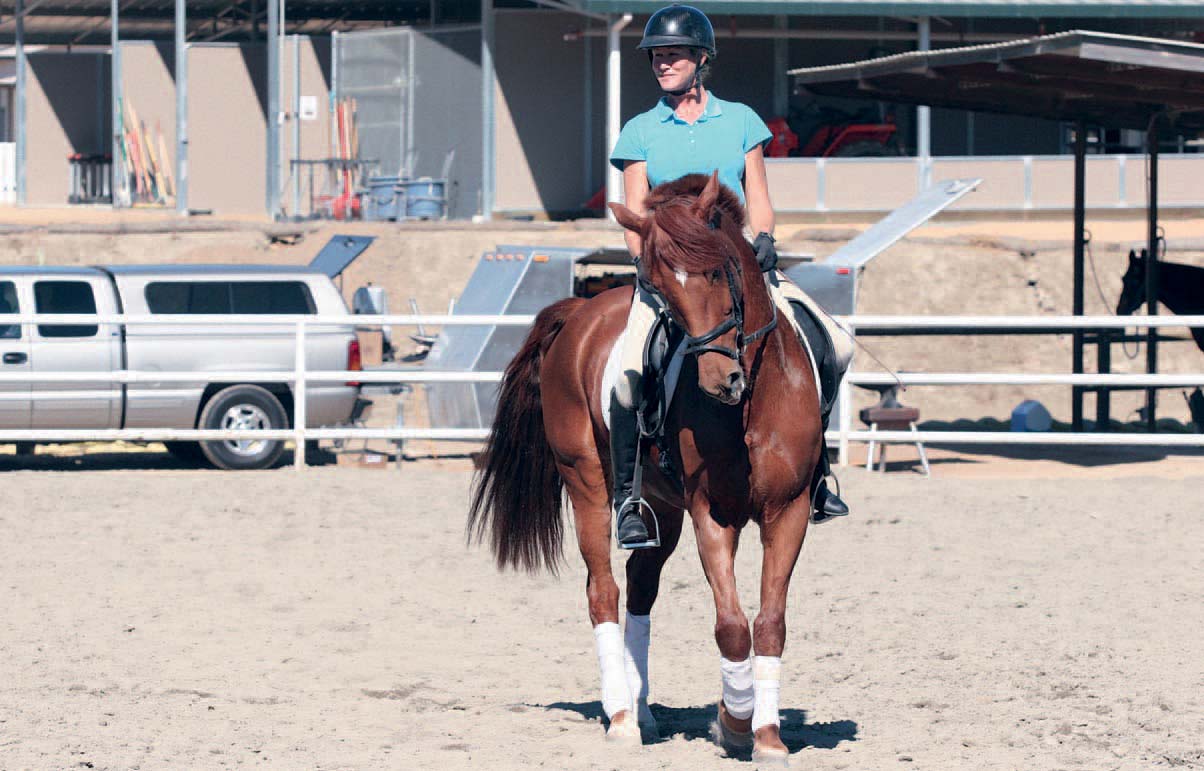
The horse begins to turn his forehand while his outside hind leg steps around the inside hind leg. The inside foreleg should march in place.
Walk down the centerline, and ride a leg yield to the right for a few strides. When you feel your horse step into and fill the outside rein, change your mind and ride in the other direction (leg yield toward the bend). This will give you a baby half pass. If all is well and he’s moving nicely forward and sideways, half halt your outside rein, and apply your outside leg. Sit to the inside, and follow the horse’s body around with your body as he turns. Each time you make another step in the turn, apply another driving aid with your inside leg, another half halt, and another turning aid with your outside aids: drive, half halt, turn, drive, half halt, turn. Keep in mind that most of the control of the turn is done with your outside rein and leg. You’ll guard his outside hindquarters with your outside aids to keep him from falling out of the turn. Your inside leg will keep the bend and tell him to keep those haunches moving while the inside rein maintains the flexion. Don’t ask for too much at once. Make a quarter turn, move forward for a bit, and then repeat the exercise.